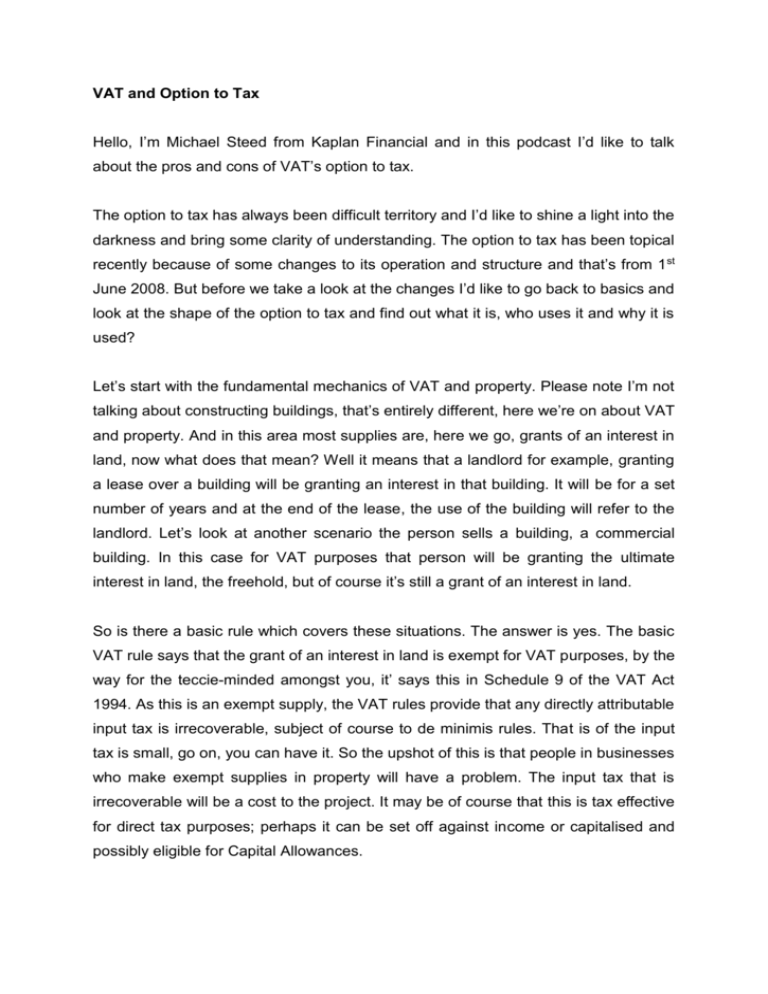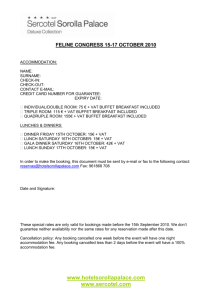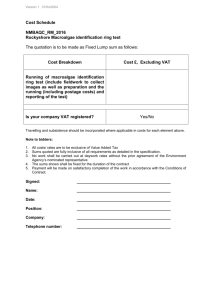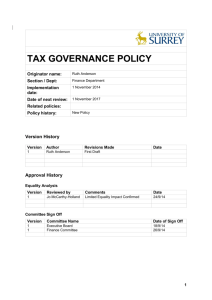VAT and Option to Tax
advertisement

VAT and Option to Tax Hello, I’m Michael Steed from Kaplan Financial and in this podcast I’d like to talk about the pros and cons of VAT’s option to tax. The option to tax has always been difficult territory and I’d like to shine a light into the darkness and bring some clarity of understanding. The option to tax has been topical recently because of some changes to its operation and structure and that’s from 1 st June 2008. But before we take a look at the changes I’d like to go back to basics and look at the shape of the option to tax and find out what it is, who uses it and why it is used? Let’s start with the fundamental mechanics of VAT and property. Please note I’m not talking about constructing buildings, that’s entirely different, here we’re on about VAT and property. And in this area most supplies are, here we go, grants of an interest in land, now what does that mean? Well it means that a landlord for example, granting a lease over a building will be granting an interest in that building. It will be for a set number of years and at the end of the lease, the use of the building will refer to the landlord. Let’s look at another scenario the person sells a building, a commercial building. In this case for VAT purposes that person will be granting the ultimate interest in land, the freehold, but of course it’s still a grant of an interest in land. So is there a basic rule which covers these situations. The answer is yes. The basic VAT rule says that the grant of an interest in land is exempt for VAT purposes, by the way for the teccie-minded amongst you, it’ says this in Schedule 9 of the VAT Act 1994. As this is an exempt supply, the VAT rules provide that any directly attributable input tax is irrecoverable, subject of course to de minimis rules. That is of the input tax is small, go on, you can have it. So the upshot of this is that people in businesses who make exempt supplies in property will have a problem. The input tax that is irrecoverable will be a cost to the project. It may be of course that this is tax effective for direct tax purposes; perhaps it can be set off against income or capitalised and possibly eligible for Capital Allowances. Before we look at the option itself let’s have a look at one other aspect of VAT in property that is relevant. A landlord may grant a lease, or as an alternative may grant a license to occupy. Now from a legal perspective there’s loads of difference between a lease and a licence but from a VAT point of view there is no difference, they are both exempt. The only area of worry here is whether a grant is the grant of an interest in land at all? For example, a hair dressing salon owner grants a self employed stylist the right to a chair and charges a chair rent. In virtually all circumstances this is not the grant of an interest in land. Instead it is a grant of the use of facilities and is standard rated for VAT purposes. Ok, so we’ve now looked at the basic VAT rule for property dealings. We’ve said so far that the supplies are normally grants of an interest in land and that these are exempt. The next point to appreciate is that there are two overrides to this basic rule and that they both default to being standard rated for VAT purposes. The first override is a statutory list within the VAT Act of supplies that cannot be exempt and therefore must be standard rated and these are in Schedule 9. These include a sale, not a lease mind, a sale of commercial properties that are less than three years old. So the sale of a small warehouse that is two years old must be standard rated. Also within this statutory list which that must be standard rated we’ve got hotel accommodation, we’ve got holiday accommodation and car parking. Remember please that these must all be standard rated for VAT. Ok, that’s the statutory overrides to the basic rule. Now let’s look at the other override. This is the override by choice and is of course the mighty option to tax. The option to tax allows a person who makes the option to turn an exempt supply into a taxable supply, an E supply into a T supply. Now why would you want to do this? Simple, by turning an E supply into a T supply you generate the ability to recover Input Tax that’s attributable to that supply. So from a taxpayer’s point of view the making of an option to tax generates cash flow advantage, Input Tax can be recovered, where otherwise it could not. Be clear about this though, the option is choice, nobody ever makes you do the option to tax, it’s always choice, although taxpayers may be commercially persuaded that it’s a good idea. I want to be absolutely clear about the effects of an option. It binds the person who made it and they must add VAT, at the standard rate, to all land supplies made from that building or land. So rent would have to have VAT added and the final sale would have VAT added as well. Are there any restrictions? Can I opt over any buildings or land? The answer is yes you can opt over buildings or land but there is one important restriction that we should be aware of. The option to tax does not work over domestic properties. You can ironically opt to tax a domestic house, it’s just that the legislation turns the option off while ever it is a house and this means of course that if ever the house was turned into an office the option would be turned back on. Do I have to own buildings or land to be able to opt? No, in fact it’s quite common not to own land or buildings that taxpayers do opt over. So are there any special rules in respect of buildings or land? The answer to this one is yes. If I opt to tax over land, and I’m talking here bare land, maybe farm land, maybe a raised development site in a city centre, the key word is choice. I can choose any bit of land I want, I simply send HMRC a map with the chosen bit of land outlined and that’s all that’s needed. There is one point to notice though. Under the June 2008 changes if you opt over bare land then any building that rises out of that opted land will automatically be opted as well unless you advise HMRC otherwise. Details here by the way, are in the all important public notice 742A which can be found on HMRC’s website. Similarly if you’ve opted over a building which you then demolish, the demolished opted building will in effect leave a shadow which will affect any new building built in its footprint. There’s also another special buildings rule, if you opt over any part of a building you are deemed to have opted over the whole of the building and any land within its, oh I love this word – curtilage, the curtilage remember is the land needed for the effective enjoyment of that property and for most properties that means the land out to the boundary. This is so, even if you only have an interest in part of the building, so the upshot of this is that you will have opted over the whole of building that in part you don’t own. Don’t worry, this is quire normal. So how long does an option last for?. The legislation basically says it’s forever. However there are two overrides to this. There’s a cooling off period of six months after its notification where a taxpayer can reverse the decision provided little or nothing has happened but there’s also an option to come out after twenty years; that is you can write to HMRC and ask to be released from the option. For the details on this please see the public notice 742A on the website. Let’s have a look now at some practical aspects. How do I make an option to tax? Well there’s a form in public notice 742A although that’s not actually legally required, you could just write a letter to HMRC. It needs to be sent by the way to their central office in Glasgow and the details of that address are in the public notice and that is the office that deals with options. Incidentally and just to underscore the point, all of these practical aspects are in the June 2008 version of pubic notice 742A. That can be found on the HMRC website, just type in ‘public notice’ on the search box if you’re struggling and it will take you through to the notices section. Generally speaking, the option can be made freely by a tax payer and notified to HMRC. Please note that the notification process is important, making an option is actually a two stage process. It’s an internal decision that doesn’t have to be made in any particular way but that is followed by the all important notification to HMRC and this should, in normal circumstances, be made within thirty days of the internal decision. In some circumstances however, the option to tax needs permission from HMRC and these are known, not surprisingly, as permission options. Generally these permission options arise where a person has already made exempt supplies for a building or land and has incurred Input Tax. This Input Tax has been irrecoverable because of the basic rule and now it is potentially recoverable because of the option and permission is required so that an agreed amount of the formerly irrecoverable input Tax can now be recovered by the taxpayer. Again for background information on permission options see the HMRC notice 742A June 2008 version on the website. One of the least understood angles on the option is exactly who is bound by it? For example if I buy a building with an option over it does that mean I’m somehow bound by that option? Well the rule is as follows, it’s only the person who makes an option that is bound by it. So if I opt to tax a commercial building and then sell it, I add VAT and that’s the end of my responsibilities. As far as the purchaser is concerned, the only thing that’s happened to him is that he’s buying a building with VAT and for him it’s normal recovery rules. If he has got taxable supplies to put the VAT against, say he’s got a trade selling widgets at the standard rate, then he can recover all of that VAT immediately. But if he’s making exempt supplies, say insurance, then he will not be able to recover any VAT and it will be a cost to him. If he’s partially exempt and the building is an overhead item then that taxpayer is going to recover according to his overhead recovery rate. To finish this podcast I want to deal with something important. It’s what happens when a building over which an option to tax has being exercised is sold with tenants in. The presence of tenants makes all the difference. It is a going concern for VAT purposes, a TOGC, the going concern of course being the landlord renting business and any VAT’d building in a TOGC will need to be carefully dealt with. Remind yourself please that a TOGC means the sale is VAT free; TOGC is technically outside the scope of VAT, neither a supply of goods nor of services. Under the rather odd rules in a TOGC where what is being sold is an opted building, the vendor is going to need to ask the purchaser whether he will continue with the option. The purchaser has two options, either yes or no. If it’s a yes, then the purchaser will need, himself, to make an option to tax and that would need to be notified to HMRC before the sale can take place. That is if the sale is to be a TOGC and therefore outside the scope of VAT. But if the purchaser says no, then the vendor has no choice, he will need to charge VAT on the building and the purchaser will then need to think how and indeed if that VAT can be recovered, but remind yourself, that’s not anything that the vendor need worry about. Well that’s it for this podcast folks, the VAT option to tax has always been difficult but hopefully that’s some use to you, and I’ll talk to you soon. Cheerio.







